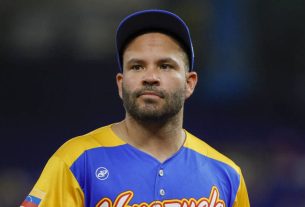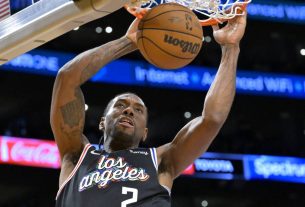The best stat to determine a player’s worth is WAR–wins above replacement–an analytical metric that was not available until relatively recently. The formula for WAR differs for position players and pitchers, and I’ll lay it out in layman’s terms. WAR uses every aspect of the game– batting, baserunning, and fielding, factors in position and ballpark and determines how many wins better than a league average player an individual player might be. Using WAR to help us rank them, let’s look at the top 24 players in the history of the New York Mets.
1 of 24
Tom Seaver 1967-1977, 1983 (78.8 WAR)
Getty Images
The Mets are a franchise rich with pitching royalty, but no player to ever wear the orange and blue is in the same league as Tom Seaver. The right-hander earned 198 of his 311 Major League wins in a Mets uniform while winning three Cy Young awards, three ERA titles, and most importantly, helped lead New York to its first World Series win in 1969. He was the Rookie of the Year in 1967, was an all-star in 10 of his first 11 seasons, and was easily inducted into the Hall of Fame in 1992. Mets fans still lament the deadline trade with the Reds in ’77 that became known as the ‘Midnight Massacre”, as to this day, it is still unimaginable how the club could’ve dealt its iconic franchise player. Seaver became a broadcaster for the Mets for many years, his number 41 is retired by the team, and there is now a statue of him outside of Citi Field.
2 of 24
David Wright 2004-2016, 2018 (49.2 WAR)
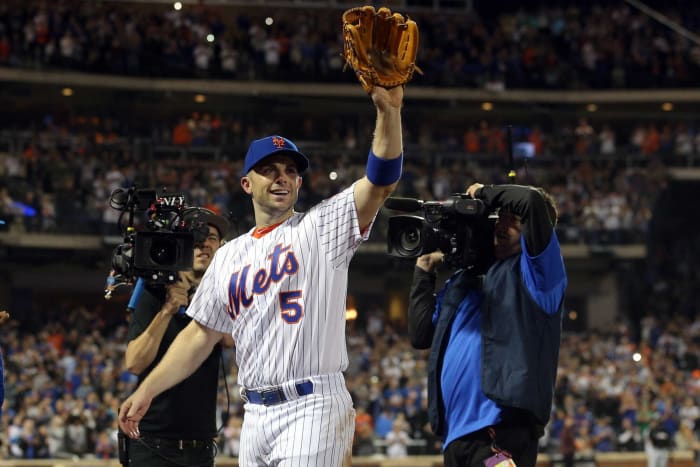
Brad Penner-USA TODAY Sports
For Mets fans, third baseman David Wright is the position player equivalent of what Seaver represented on the mound. Wright was a homegrown high draft pick, who went on to become the face of the team for over a decade. The Virginia native was a seven-time all-star, a two-time Silver Slugger winner, and captured two Gold Glove awards. He drove in over 100 runs in five different seasons and helped take this team three wins from a World Championship back in 2015. Wright retired as the franchise’s all-time leader in hits, runs, RBI, doubles, total bases, and walks and could have even more records had his career not unfortunately been dramatically shortened by spinal stenosis. Wright’s iconic number five has not yet been officially retired by the team, but it will be.
3 of 24
Dwight Gooden 1984-1994 (46.4 WAR)
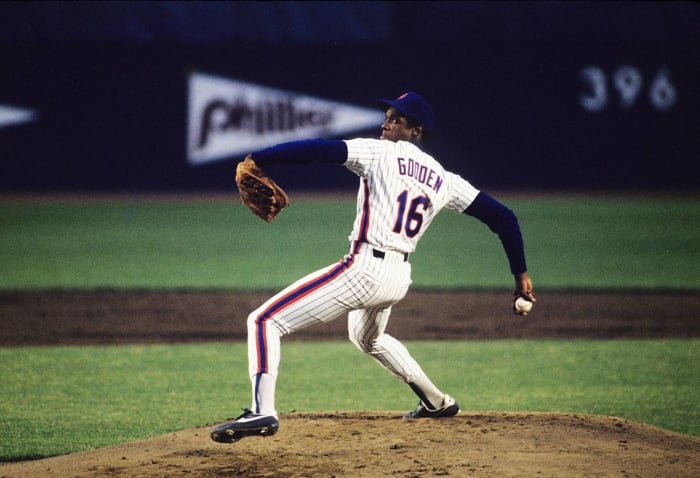
RVR Photos-USA TODAY Sports
When Dwight Gooden burst onto the scene in 1984, he instantly became everything the Mets had been missing since Seaver’s departure and more. When Gooden pitched in New York in the mid 80’s, there’s no way to describe it other than an event. And if you weren’t at the game, it was must-see tv. Gooden was the NL Rookie of the Year in ’84 and then became a machine the following season. Just look at his stat line from 1985. In 35 starts, he went 24-4 with a 1.53 ERA and 16 complete games. He struck out 268 hitters in 276.2 innings en route to winning the Cy Young award and the pitching triple crown. As a 21-year-old, he was front and center during the Mets championship season of 1986 and had it not been for off-the-field issues that derailed his career at times, he would’ve been a sure-fire Hall of Famer.
4 of 24
Jacob deGrom 2014-2022 (43.8 WAR)
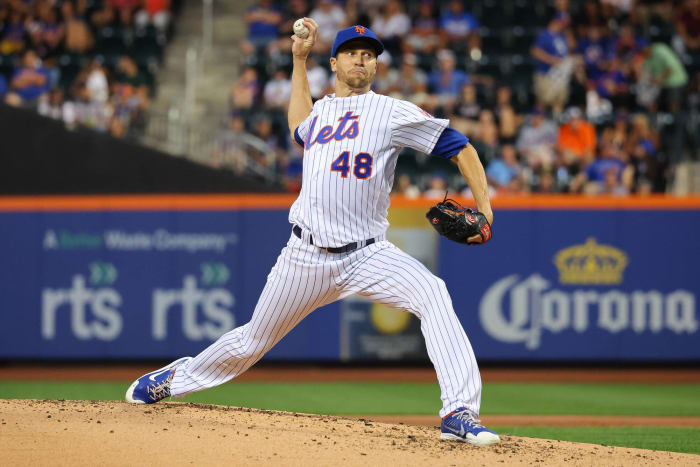
Brad Penner-USA TODAY Sports
When Jacob deGrom was first called up by the Mets in May of 2014 the plan was for him to pitch out of the bullpen. But an injury to Dillon Gee that week forced him into the rotation, and it’s fair to say the rest is history. deGrom hit the ground running and was the NL Rookie of the Year, and the following season played a major role in the Mets reaching their first World Series in 15 years. But his best days were yet to come. The righty would go on to win back-to-back Cy Young awards in ’18 and ’19 and nearly made it a three-peat in the pandemic-shortened 2020 season. The 34-year-old was selected to four all-star teams as a Met, and while his New York tenure ended disappointingly with multiple injuries, and the sting is still fresh from him signing with Texas as a free agent shortly after Thanksgiving, deGrom will easily go down as one of the best Mets in the franchise’s history.
5 of 24
Jerry Koosman 1967-1978 (36.9 WAR)
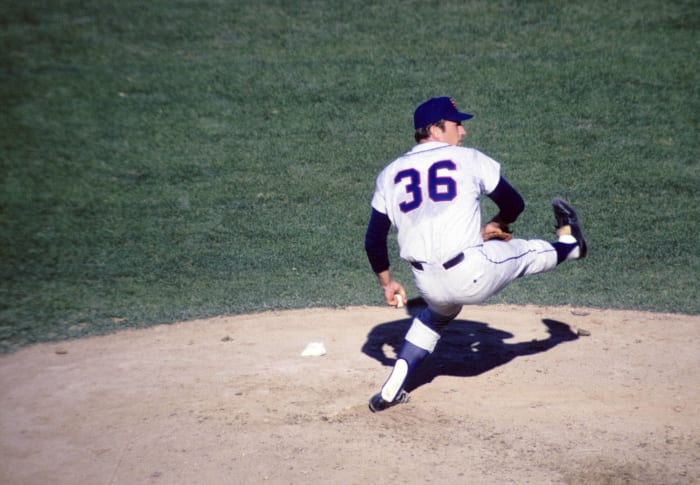
D. Raphael-USA TODAY Sports
Lefty Jerry Koosman was often underappreciated during his Mets tenure because he was pitching in the same rotation as Tom Seaver. Still, it’s essential to understand that he would have been the ace on most other teams. In 12 years in New York, Koosman won 140 games with a 3.09 ERA. He was elected to two all-star teams, helped the Mets win the 1969 World Series, and in August of ’21, the club retired his number 36.
6 of 24
Darryl Strawberry 1983-1990 (36.6 WAR)

RVR Photos-USA TODAY Sports
While the aforementioned David Wright owns virtually every major offensive Mets club record, one noticeable one he does not have is home run leader. That title belongs to Darryl Strawberry, who, at his peak, had as much pure power as any hitter in the game. During his tenure in New York, Strawberry was the 1983 Rookie of the Year, made seven consecutive all-star teams, and won two Silver Slugger awards. He hit more than 26 home runs in every one of his eight seasons in Queens, won the 1986 home run derby, and then helped the Mets win the World Series later that fall. Strawberry left New York to join the Dodgers as a free agent following the 1990 campaign but has recently spoken about regretting the decision to leave the Mets.
7 of 24
Carlos Beltran 2005-2011 (31.1 WAR)
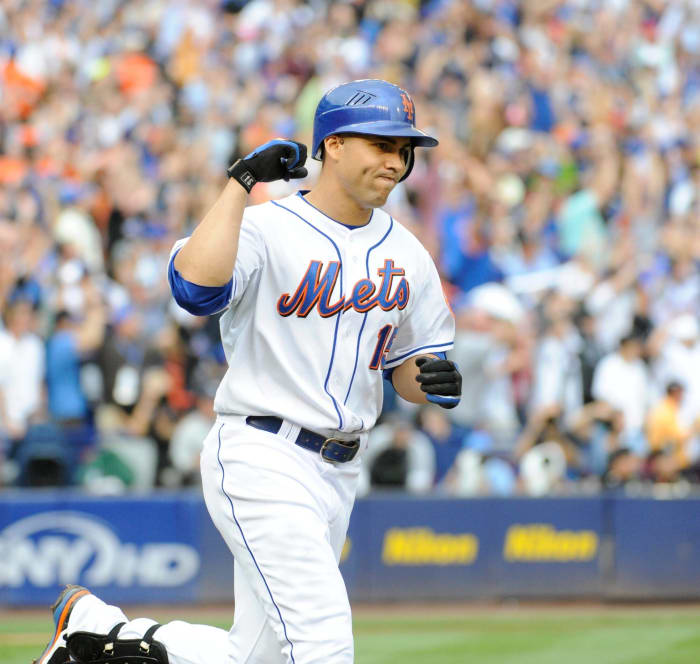
Robert Deutsch, USAT via Imagn Content Services, LLC
When Omar Minaya took over as Mets’ GM late in 2004, he was determined to make a big free-agent splash in his first offseason. And he accomplished that goal emphatically when he added the winter’s best available player, center fielder Carlos Beltran. The switch-hitter’s time with the Mets is disappointingly most remembered for striking out to end the 2006 NLCS, but in his prime, Beltran was as dynamic a player as the Amazins have ever had. In seven seasons in New York, he slashed .280/.369/.500 with 149 homers and 559 RBI. He stole 100 bases, added 208 doubles, 17 triples. As a Met Beltran was selected to five all-star games, and won two Silver Sluggers, and three Gold Gloves, yet to this day is still somewhat underappreciated.
8 of 24
Edgardo Alfonzo 1995-2002 (29.6 WAR)
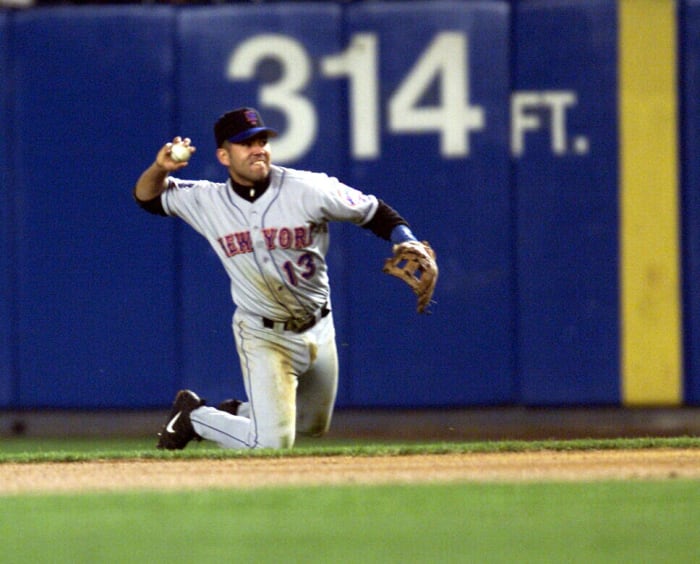
USA TODAY-USA TODAY NETWORK
While Mike Piazza was undoubtedly the face of the good Mets teams of the late 90s and early 2000s, let’s not forget that he had one heck of a running mate. Infielder Edgardo Alfonzo came up as a third baseman but shifted to second when the Mets signed Robin Ventura a few years later and handled the switch without the slightest hiccup. Offensively he was never a star necessarily, but Alfonzo was a steady and reliable presence in this line-up day in and day out. His best year was undoubtedly 1999 when he hit .304 with 27 homers and 104 RBI and made the all-star team and won a Silver Slugger. In the ’99 NLDS against Arizona, the right-handed hitter crushed three homers and drove in six runs to help New York advance. After his playing career was over, Alfonzo would go on to become a coach in the Mets minor league system for several years.
9 of 24
Sid Fernandez 1984-1993 (29.2 WAR)
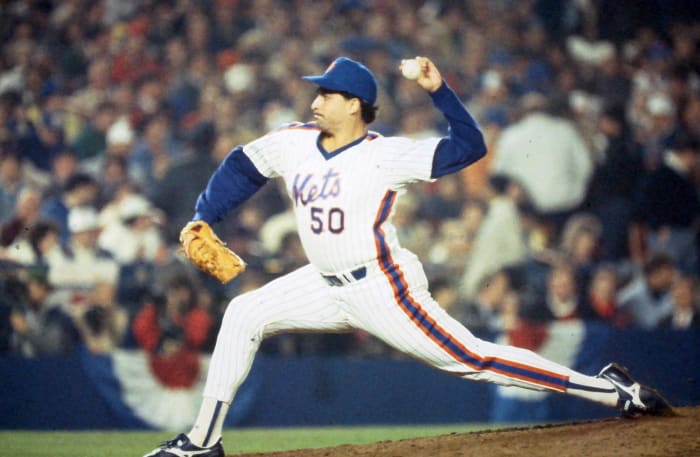
Frank Becerra Jr/USA TODAY / USA TODAY NETWORK
Eccentric southpaw Sid Hernandez was certainly not the biggest name on the Mets’ pitching staff in the 80s, but he was, without question, an essential part of this team for a long time. During his Queens tenure, Fernandez took the ball 255 times and pitched to a stellar 3.14 ERA in almost 1600 innings. He was an all-star in ’86 and ’87 and was a bit of an unsung hero for this team during their run to the 1986 World Series. Fernandez left the Mets in ’93 to join the Orioles as a free agent and later pitched for the Phillies and Astros, but he is still most known for his work in New York.
10 of 24
Jose Reyes 2003-2011, 2016-2018 (28.1 WAR)
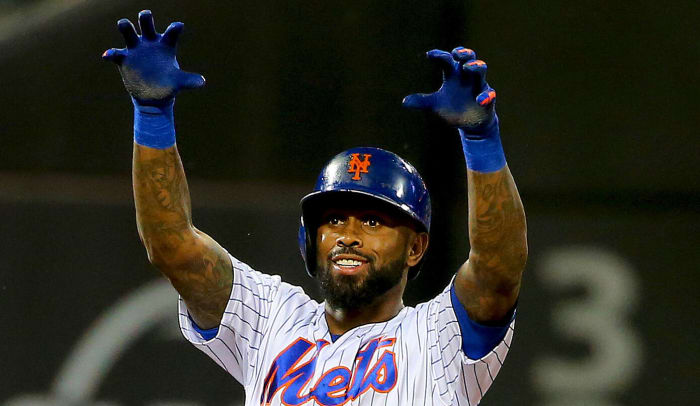
Andy Marlin-USA TODAY Sports
When shortstop Jose Reyes was at his peak, there simply was not a more exciting play in baseball than watching him race home to third in the blink of an eye. Early in his career, Reyes’ ability to affect the game with his legs was an element we just hadn’t seen, perhaps since Rickey Henderson. The switch-hitter led the league in triples four times and steals three straight years from ’05-’07. He never hit more than 19 homers or drove in more than 81 runs, but for most of his career, Reyes was the premier leadoff hitter in the sport. He was a four-time all-star, a Silver Slugger winner, and won the batting title in 2011, and it was nice to see him return to the Mets in 2016 to finish his career.
11 of 24
Jon Matlack 1971-1977 (27.1 WAR)
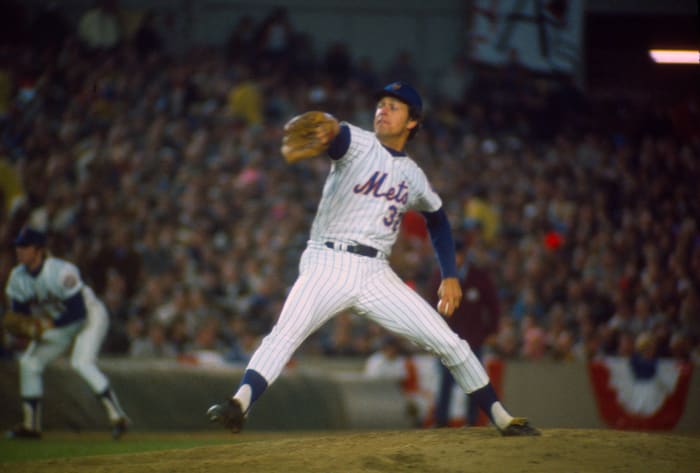
Photo by Focus on Sport/Getty Images
New York drafted left-hander Jon Matlack fourth overall in the 1967 draft. While he’d yet to reach the Major Leagues during the club’s magical run to ’69 World Series, the West Chester, PA native immediately began making a name for himself following his 1971 arrival. Slotted in as the Mets’ third starter behind Seaver and Koosman, Matlack often matched up against other team’s middle-of-the-rotation starters, and more often than not he beat them. In 203 outings as a Met Matlack pitched to a terrific 3.03 ERA. He made the all-star team three times, and was the 1972 NL Rookie of the Year. In the 1973 postseason, Matlack allowed only four earned runs in 25.2 innings, helping New York to the National League pennant.
12 of 24
Keith Hernandez 1983-1989 (26.6 WAR)
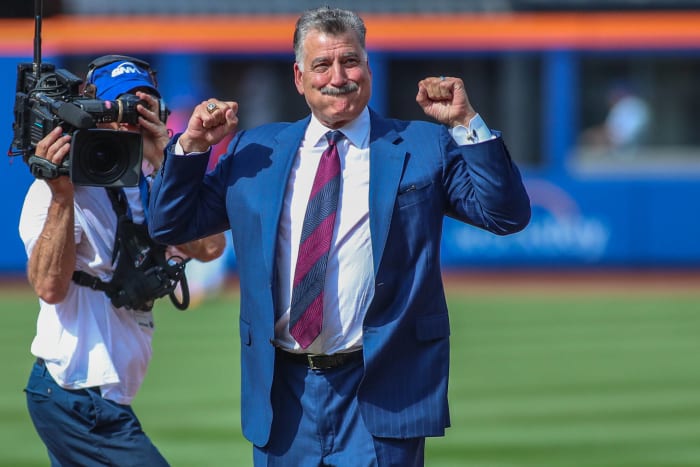
Wendell Cruz-USA TODAY Sports
When first baseman Keith Hernandez first learned he was being traded from the Cardinals to the Mets in 1983, the veteran was not happy. Hernandez regarded himself as a winning player and had already been a two-time all-star, an MVP, a six-time Gold Glove winner, a batting champion, and a World Champion in St. Louis. In contrast, the Mets had not won anything in over a decade. New York, though quickly managed to win Hernandez over. The Mets already had budding young stars in Dwight Gooden and Darryl Strawberry, and adding a winning veteran player like Hernandez–along with catcher Gary Carter–really put this team over the hump. In his third full season in New York Hernandez helped lead the Mets to a World Series championship, cementing himself as royalty in the biggest sports market in the country. Today he serves as a beloved broadcaster for the Mets, and the team retired his number 17 just this past summer.
13 of 24
Al Leiter 1998-2004 (26.4 WAR)
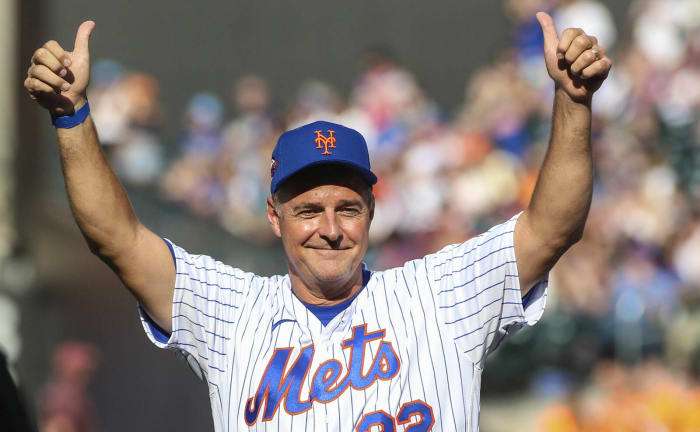
Wendell Cruz-USA TODAY Sports
Al Leiter was a good pitcher for the Yankees, Blue Jays, and Marlins, but when he arrived in Queens in 1998, it was almost like he was born to be a Met. The southpaw immediately became a fan favorite at Shea Stadium, and he delivered some of his best seasons in the orange and blue. In 213 starts for the Mets across seven years, Leiter won 95 games with a 3.42 ERA. His signature moment for New York was the complete game shutout he fired in Cincinnati in ’99 in game 163 as the Mets and Reds had tied for the Wild Card. The following year Leiter helped lead the Amazins to their first National League pennant in 14 seasons, and he is still remembered incredibly fondly by this organization and its fans.
14 of 24
Mike Piazza 1998-2005 (24.6 WAR)
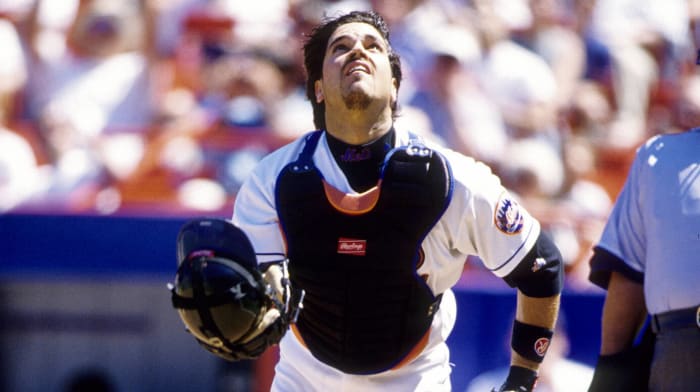
RVR Photos-USA TODAY Sports
The Mets have had some good and even great players in their history, but I don’t know that they’ve ever had another player that was essentially an instant rockstar like Mike Piazza was. The superstar catcher was unprecedently available to be had in a trade in 1998. Even more unusual was the fact that the Marlins were the team that acquired him from the Dodgers, solely intending to flip him for better prospects a week later. Piazza ultimately ended up in Queens, where he got off to a slow start but quickly got acclimated to the environment and grew to love it. Fans were hesitant to get too attached during those first few months since he was a free agent at year’s end, but when Piazza re-upped in New York he had the fanbase in the palm of his hand. He’d go on to crush 220 homers as a Met–including some incredibly memorable ones like the blast he hit against Atlanta in the first game after 9/11. Piazza helped lead the Mets to back-to-back playoff appearances in ’99 and ’00 and deservedly has his number 31 retired at Citi Field.
15 of 24
Howard Johnson 1985-1993 (22.1 WAR)

Mark J. Rebilas-USA TODAY Sports
Switch-hitter Howard Johnson came to the Mets in a 1984 trade with the Mets, and in nine seasons with New York, really became a beloved member of this organization. Johnson helped the Mets win the World Series in 1986, but later in his career blossomed into one of the more dangerous offensive players in the sport. In 1991 he led the league in both home runs (38) and RBI (117), and very nearly won the National League MVP award. Johnson’s versatility was immensely valuable as during his team with New York, he played third base, shortstop, and all three outfield positions. He would later coach in both the Mets minor league system and on the big league staff.
16 of 24
Mookie Wilson 1980-1989 (20.8 WAR)
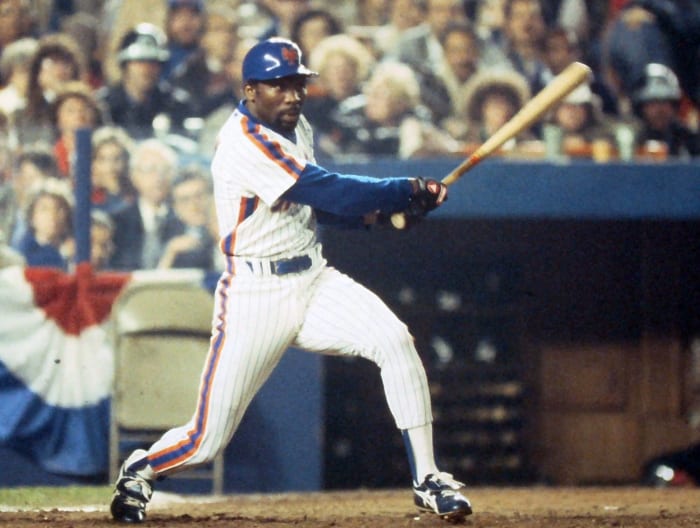
Frank Becerra Jr/USA TODAY / USA TODAY NETWORK
While nearly every player mentioned in this gallery was a fan favorite in New York, speedy outfielder Mookie Wilson might take that title to a new level. Wilson was a platoon player in center field for the Mets for much of his career, but he seemed to make a difference whenever he played. Wilson is second behind Jose Reyes on the Mets all-time triples and steals lists, and was one of the premier defensive players in the league for the entirety of his career. Following his playing career, like Howard Johnson, he too coached in this organization for a long time.
17 of 24
David Cone 1987-1992, 2003 (20.2 WAR)

Gary Rothstein/Icon Sportswire
David Cone pitched for several different Major League teams, and while it might not feel like it, he actually spent more time in Queens than anywhere else. As a Met the right-hander shared a rotation with big names like Dwight Gooden, Ron Darling, and Sid Fernandez, but at his best Cone was every bit as good as anyone on this staff. The fact that he didn’t win the Cy Young award in 1988 after going 20-3 with a 2.22 ERA and striking out 213 hitters in 231.1 innings is insane and just goes to show how incredible Orel Hershiser was for the Dodgers that season. Cone left the Mets to join the Royals as a free agent in ’93, and it’s fair to wonder where he would have ended up on New York’s pitching pantheon had he decided to stay.
18 of 24
John Stearns 1975-1984 (19.6 WAR)

North Jersey-USA TODAY NETWORK
There haven’t been many Major Leaguers who played with the level of passion and fire that catcher John Stearns brought to the field daily. Stearns played all but one of his career games as a Met, and brought the type of leadership and energy that the team needed during some lean years in the late ’70s and early ’80s. Known as the ‘Bad Dude’, Stearns made the all-star team on four separate occasions and it was pretty cool to see him get to participate in Old Timers day at Citi Field this past summer, just a few weeks before he passed away.
19 of 24
Bud Harrelson 1965-1977 (18.7 WAR)
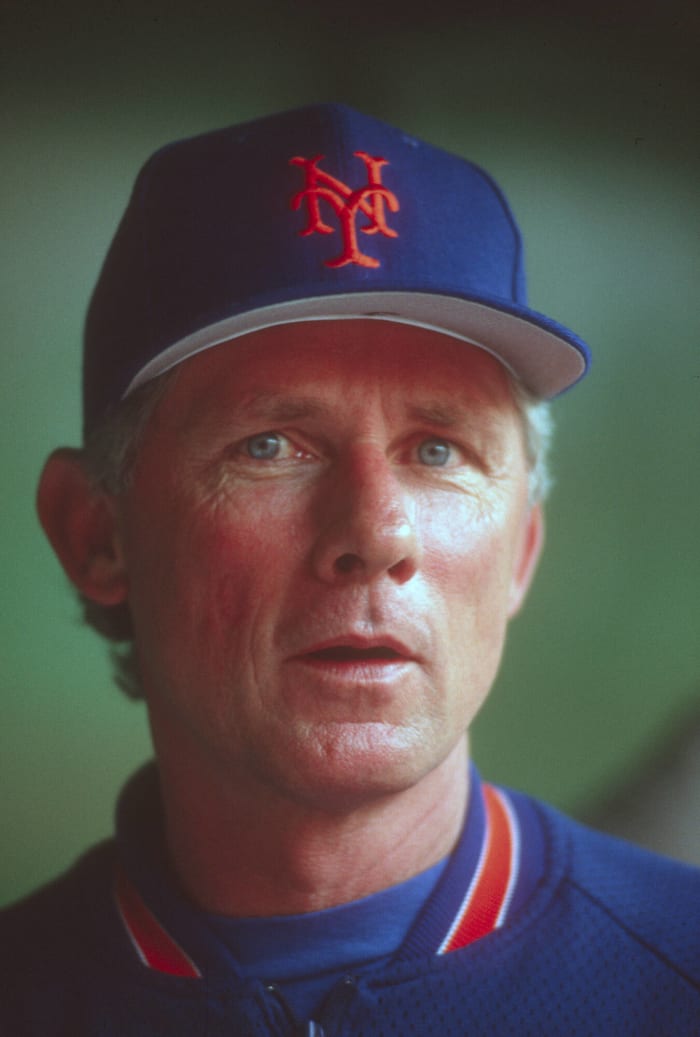
Photo by Focus on Sport/Getty Images
Infielder Bud Harrelson spent most of his 16-year career in New York with the Mets, and while he was not much of an offensive player, he was still a valuable part of some pretty good Mets teams. Harrelson was a steady defensive presence up the middle for his entire career, and his scrappy nature endeared him to teammates and fans alike. He was an all-star in both 1970 and 1971, won a Gold Glove, and was the shortstop on New York’s 1969 championship team. But he’s perhaps best remembered for getting into a fight at second base with Pete Rose during the 1973 NLCS. Harrelson would later earn a second World Series ring with the Mets as a coach on Davey Johnson’s staff in ’86.
20 of 24
Cleon Jones 1963, 1965-1975 (18.2 WAR)
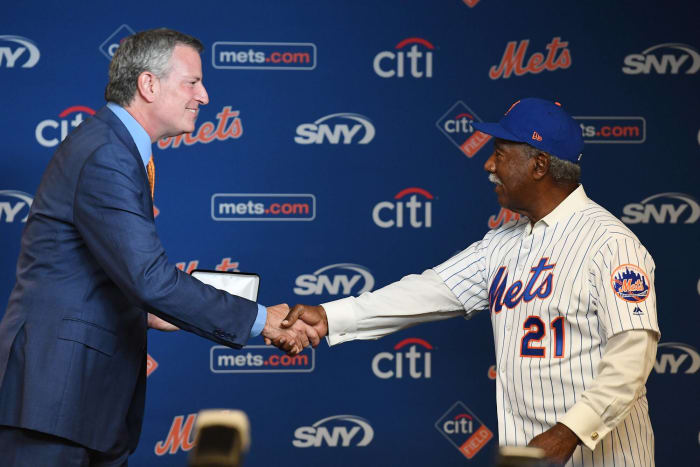
Michael Karas/NorthJersey.com
While the Mets have historically been known mostly as a pitching franchise, each time they’ve been really good, they’ve needed an offensive star or two to carry the load. And in 1969, that guy was left fielder Cleon Jones. The Alabama native played all but 12 of his big league games in a Mets uniform but was never better than he was during the team’s magical run to the pennant 53 years ago. 137 games that season Jones slashed .340/.422/.482 with 12 homers and 75 RBI, and was often the linchpin whenever the club needed a clutch rally. He was an all-star that season and was even in the MVP discussion, and he’s fondly remembered today by fans of every generation for being the guy that caught the last out of the Mets first championship.
21 of 24
John Olerud 1997-1999 (17.3 WAR)
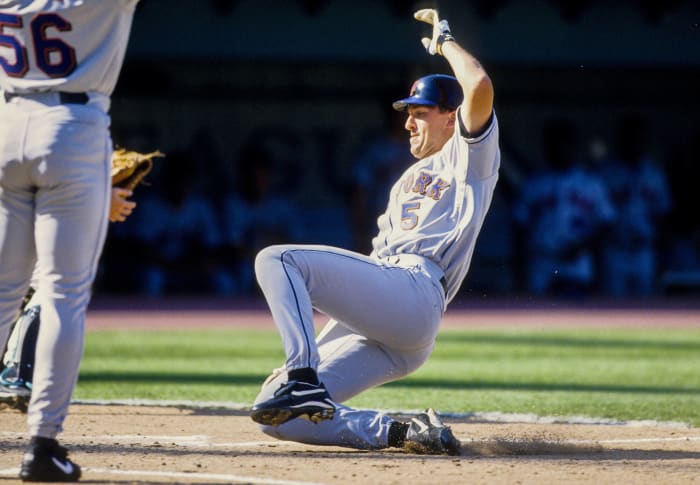
RVR Photos-USA TODAY Sports
First baseman John Olerud only spent three seasons in Queens, so his mere presence on this list should speak volumes about his impact. During those three campaigns, Olerud missed only 10 games TOTAL and was steady and reliable both on defense and in the middle of this line-up. His .354 batting average in 1998 remains the single-season club record, and his ability to drive in 93 or more runs in each of his three years in Queens illustrates his ability to help put runs on the board. Olerud was also part of New York’s famed ‘best infield ever’ that graced the cover of Sports Illustrated, as he teamed with Edgardo Alfonzo, Rey Ordonez, and Robin Ventura to form an unprecedented defensive foursome. Olerud left the Mets to go to his hometown Seattle as a free agent in 2000.
22 of 24
Brandon Nimmo 2016-present (17.2 WAR)
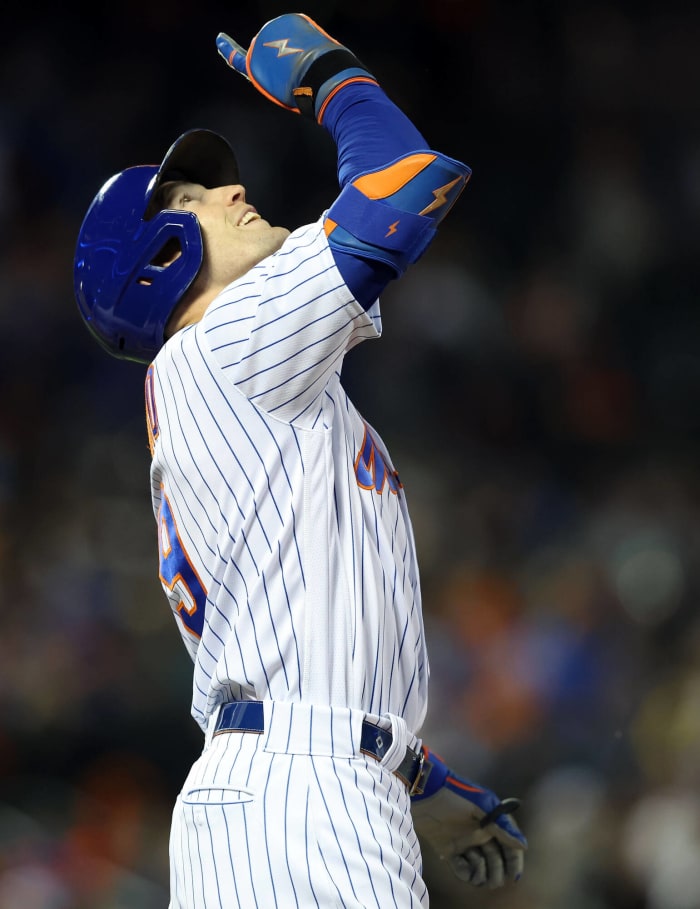
Brad Penner-USA TODAY Sports
The Mets made outfielder Brandon Nimmo the 13th overall pick in the 2011 draft, and while it took a while for him to make an impact, the Wyoming native was worth the wait. The center fielder has been an on-base machine throughout his career, as evidenced by his .269/.385/.441 lifetime slash line. He’s got sneaky power and has seasons of 16 and 17 home runs on his resume. But his calling card will always be his innate ability to be an elite leadoff hitter that works the count, gets pitcher’s pitch count up, and most importantly gets on base. Nimmo just inked a lucrative eight-year free-agent contract to remain with the Mets, so he obviously will shoot up this list before his career is over.
23 of 24
Rick Reed 1997-2001 (17.1 WAR)
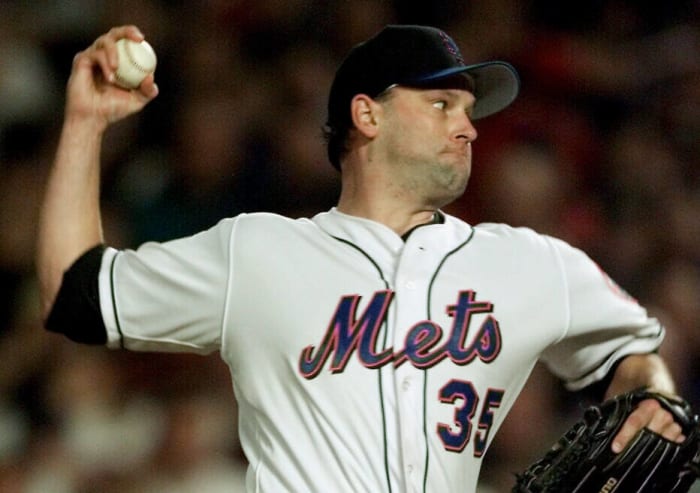
USA TODAY-USA TODAY NETWORK
Righty Rick Reed was 32 when he arrived in Queens as a free agent, and it was fortuitous timing for the Mets as he promptly delivered the best stretch of his career. In Reed’s first season in New York he delivered a career-best 2.89 ERA in 208.1 innings, and both of his two career all-star appearances came in a Mets uniform. His time in New York was brief but for all five seasons, Reed was a steady and reliable force in the middle of the Mets rotation, and he’s perhaps most known for pitching the only game the Amazins won in the World Series in 2000.
24 of 24
Tom Glavine 2003-2007 (17.1 WAR)

Howard Smith-USA TODAY Sports
It feels strange to talk about Tom Glavine as an all-time Mets great, but believe it or not, the Braves legend cracks New York’s top 24 WAR leaders. The southpaw pitched five seasons in Queens and was an all-star in two of them–including his age-40 season. What’s interesting about Glavine’s Mets’ tenure is that it’s remembered for two precise things, on complete opposite ends of the spectrum. On the final day of 2007 Glavine got lit up in the first inning by the Marlins, taking the loss in what ultimately was the final nail in the coffin in New York’s frustrating late-season collapse. On a more positive note, in that same ’07 season, he earned his 300th win, which is essentially a golden ticket to the Hall of Fame. He was inducted in 2014.

